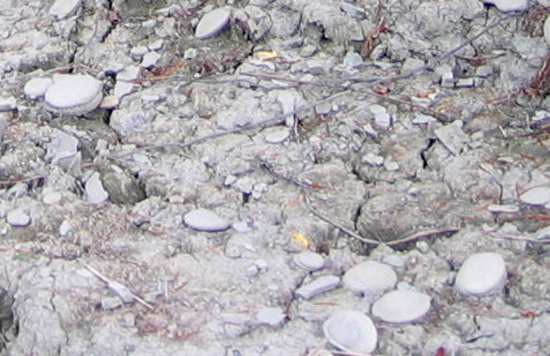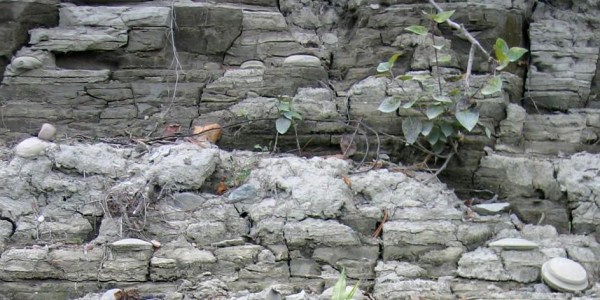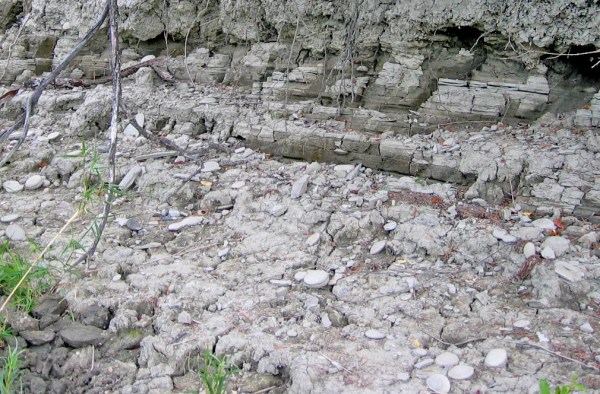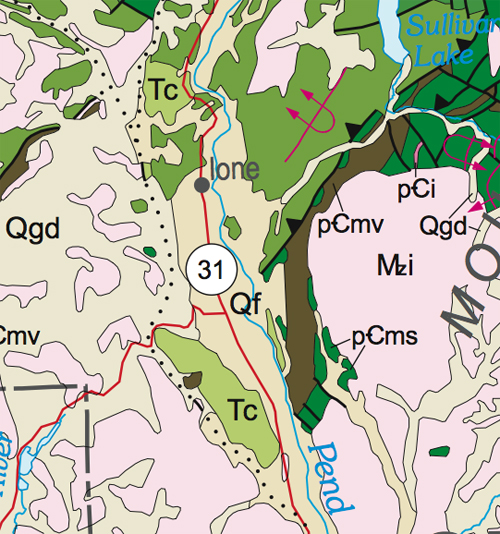Geopuzzle: What are these things? (UPDATED)
Earlier this year a reader sent me a photograph of some rocks they had come across asking me what I thought they were or might represent. I ended up posting the photograph here as a ‘geopuzzle’ and asked all of you to comment on it with your thoughts (see that post here). It was pretty fun and worked so well that I thought I’d do it again.
A few weeks ago a reader sent me a couple photos of some interesting features in some fine-grained sedimentary rocks near her home in northeastern Oregon Washington. I replied with my own educated guess but would like to see what you all think.
The features of interest in these rocks are the numerous saucer-shaped rocks eroding out of the outcrop.
In the photo above you can see these ‘saucers’ in lower right of photo as float.
Again, look at the lower right of the photo above for another view.

zoomed-in part of previous photo showing disc-shaped features eroding out of the outcrop (photograph from a reader)
So, add your two cents below and I’ll summarize the consensus on this geopuzzle tonight or tomorrow with an update.
–
UPDATE (12/8/2009): Well thanks to everybody for ‘playing’. Here is my initial response to the reader regarding these saucer-shaped features:
It’s difficult to tell for sure w/ that photo … but my gut instinct is that the saucer-shaped stones are “concretions”, which are features that form after deposition (sometimes millions yrs after) from differential chemical cementation. The wikipedia page is actually pretty good for this: http://en.wikipedia.org/wiki/ConcretionThat’s just my best guess from that photo and your description … I could be wrong.



My first guess would be a kind of concretions, possible diagenetic. Though I got to admit I never before sauce such UFO-like concretions before. What size are they? A few cm?
My first thought is that these are load casts or some kind of soft-sed deformation & dewatering structures. Exposed by differential weathering.
However, their orientation (convex up) might suggest some alternate provenance, such as some kind of diagenetic concretionary feature with the mineralization “front” expanding from its nucleation site symmetrically in the horizontal dimension, but restricted vertically. Thus the kind of “bun” shape.
Northeastern Oregon, eh? What formation? Are they Mesozoic marine, or Cenozoic metasedimentary? Some kind of turbidite sequence might favor the load structure hypothesis, but I’d really like to get a sub-mesoscopic view and some kind of stratigraphic/facies framework to better separate observation/interpretation.
Very neat regardless – these are the kinds of things that are fun to throw at students and say “what is this and how did it form?”
Yeah, definitely looking like concretions where the catalyzing groundwater flow is constrained by permeability barriers in the stratification. In other words, these concretions “want” to grow into spheres, but as they get bigger and bigger, they find the layers above and below aren’t as easy to grow into, so the rate of precipitation along the lateral edges is faster, and the rate of precipitation at the “poles” is slower. This interpretation could be tested by cutting one in half to see if it has a spherical shape when it started growing that transitioned to “UFO” shapes as they grew larger. There are some big “wagon wheel” type concretions on a beach somewhere near San Francisco that I remember seeing — much larger versions of the same thing.
Clay sediment rocks from a desert wash?
….oh, the round ones look like river rocks of some sort, perhaps rounded out cement from abrasive silty erosion from upstream?
I’m going with concretions as well. Odd shapes such as these ellipsoids are pretty common. It also looks as if there are distinct horizons where the objects are forming, which is, again, typical for concretions.
My only puzzlement is that in the far NE portion of the state, I don’t know of mudstones/siltstones like this… almost everything is igneous or metamorphic. And almost everything older than the CRB is seriously deformed. Did your reader say more specifically what the location is?
Concretions, possibly calcareous, possibly nucleated by mollusc shells (that lowermost object in the third close-up photo looks suspiciously like a clam valve, but maybe just a superficial resemblance). The deposits could be lacustrine; very similar-looking beds with very similar-looking concretions occur in south-central British Columbia (Okanagan Valley); there they are Quaternary lake bed deposits.
I’m with Lockwood in wanting to know more specifically where these are located, because flat siltstones do not jibe with mental geologic map of Oregon Are we looking at another Anthropocene stratigraphic marker – the skeet-shooting clay pigeon layer?
I think you’re misleading us by calling this exposure an outcrop of rocks. It looks like floppy sloppy lake beds, or Missoula Flood beds, east of the Wallula Gap. These would be clean silts with a component of fresh basalt particles, which would release calcium and iron promoting cementation. It’s hard to tell, but it looks like the concretions are restricted to a few horizons. I’ll bet these hockey pucks have very little strength. There would be no diagenesis. I also note that there are several dogbone concretions, where two grew together.
People in my forum bring me concretions all the time; I add them to my photo collection.
Following up on Andrew’s comment, Missoula Flood beds were what came to my mind as well, but I was and am uncertain that 10 Ka would be enough time to get concretions of that size. Anne, you’ve spent some time looking at this stuff, haven’t you? Have you ever seen concretions in Missoula sediments?
Hey everybody … my bad, the site is in NE Washington. Sorry about that.
This site is along the Pend Oreille River near the town of Ione, Washington. Again, sorry about the confusion … but those of you who felt confused can feel good about your geo-instincts!
Not too far from Howard’s Okanagan Valley, and a similar looking environment.
Obviously clay pigeons. Imagine an aghast Kennewick-ish man at shooting practice when a giant flood from Montana rolls in. (?)
Symmetry is troubling for a primary feature. In any case, I want one.